2013 Hyundai Sonata Hybrid hybrid system warning
[x] Cancel search: hybrid system warningPage 374 of 425
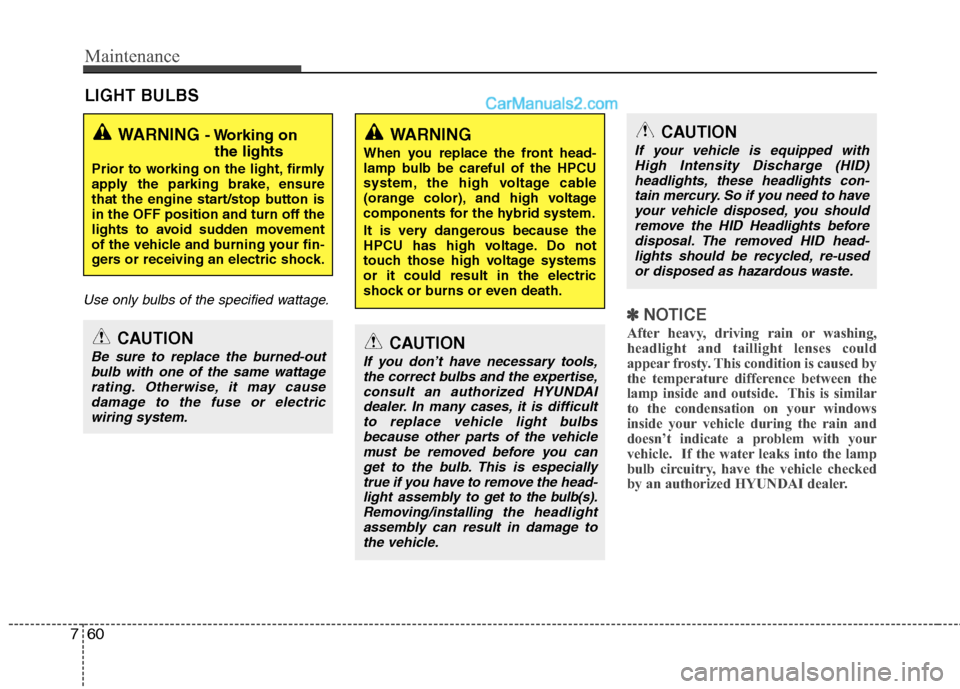
Maintenance
60 7
LIGHT BULBS
Use only bulbs of the specified wattage.
✽
✽
NOTICE
After heavy, driving rain or washing,
headlight and taillight lenses could
appear frosty. This condition is caused by
the temperature difference between the
lamp inside and outside. This is similar
to the condensation on your windows
inside your vehicle during the rain and
doesn’t indicate a problem with your
vehicle. If the water leaks into the lamp
bulb circuitry, have the vehicle checked
by an authorized HYUNDAI dealer.
WARNING - Working on
the lights
Prior to working on the light, firmly
apply the parking brake, ensure
that the engine start/stop button is
in the OFF position and turn off the
lights to avoid sudden movement
of the vehicle and burning your fin-
gers or receiving an electric shock.
CAUTION
Be sure to replace the burned-out
bulb with one of the same wattage
rating. Otherwise, it may cause
damage to the fuse or electric
wiring system.CAUTION
If you don’t have necessary tools,
the correct bulbs and the expertise,
consult an authorized HYUNDAI
dealer. In many cases, it is difficult
to replace vehicle light bulbs
because other parts of the vehicle
must be removed before you can
get to the bulb. This is especially
true if you have to remove the head-
light assembly to
get to the bulb(s).
Removing/installingthe headlight
assembly can result in damage to
the vehicle.
WARNING
When you replace the front head-
lamp bulb be careful of the HPCU
system, the high voltage cable
(orange color), and high voltage
components for the hybrid system.
It is very dangerous because the
HPCU has high voltage. Do not
touch those high voltage systems
or it could result in the electric
shock or burns or even death.
CAUTION
If your vehicle is equipped with
High Intensity Discharge (HID)
headlights, these headlights con-
tain mercury. So if you need to have
your vehicle disposed, you should
remove the HID Headlights before
disposal. The removed HID head-
lights should be recycled, re-used
or disposed as hazardous waste.
Page 383 of 425
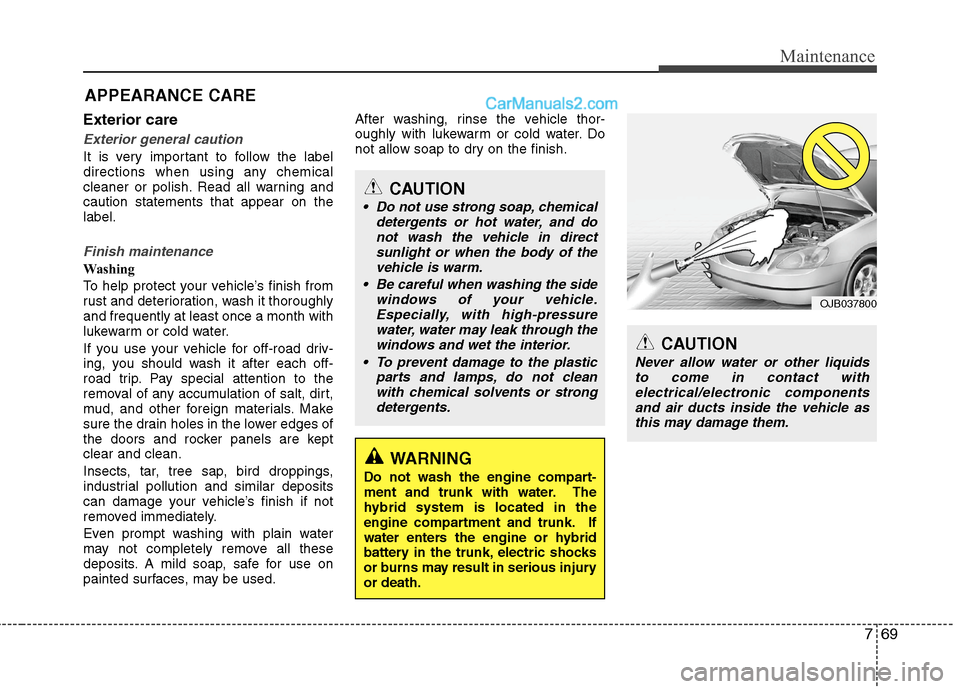
769
Maintenance
APPEARANCE CARE
Exterior care
Exterior general caution
It is very important to follow the label
directions when using any chemical
cleaner or polish. Read all warning and
caution statements that appear on the
label.
Finish maintenance
Washing
To help protect your vehicle’s finish from
rust and deterioration, wash it thoroughly
and frequently at least once a month with
lukewarm or cold water.
If you use your vehicle for off-road driv-
ing, you should wash it after each off-
road trip. Pay special attention to the
removal of any accumulation of salt, dirt,
mud, and other foreign materials. Make
sure the drain holes in the lower edges of
the doors and rocker panels are kept
clear and clean.
Insects, tar, tree sap, bird droppings,
industrial pollution and similar deposits
can damage your vehicle’s finish if not
removed immediately.
Even prompt washing with plain water
may not completely remove all these
deposits. A mild soap, safe for use on
painted surfaces, may be used.After washing, rinse the vehicle thor-
oughly with lukewarm or cold water. Do
not allow soap to dry on the finish.
CAUTION
Do not use strong soap, chemical
detergents or hot water, and do
not wash the vehicle in direct
sunlight or when the body of the
vehicle is warm.
Be careful when washing the side
windows of your vehicle.
Especially, with high-pressure
water, water may leak through the
windows and wet the interior.
To prevent damage to the plastic
parts and lamps, do not clean
with chemical solvents or strong
detergents.
WARNING
Do not wash the engine compart-
ment and trunk with water. The
hybrid system is located in the
engine compartment and trunk. If
water enters the engine or hybrid
battery in the trunk, electric shocks
or burns may result in serious injury
or death.
CAUTION
Never allow water or other liquids
to come in contact with
electrical/electronic components
and air ducts inside the vehicle as
this may damage them.
OJB037800
Page 385 of 425
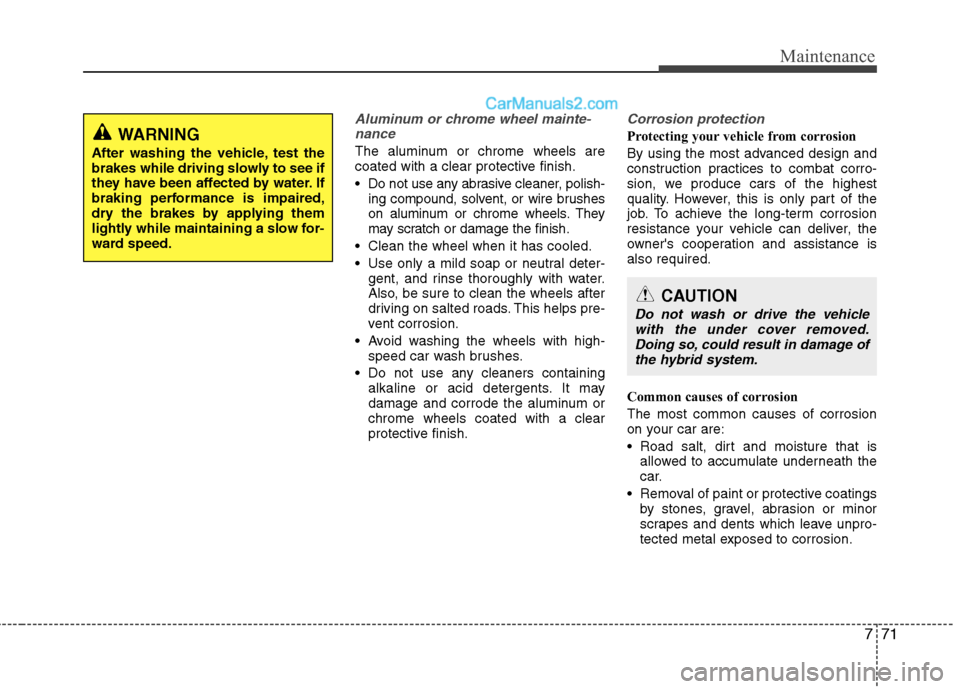
771
Maintenance
Aluminum or chrome wheel mainte-
nance
The aluminum or chrome wheels are
coated with a clear protective finish.
Do not use any abrasive cleaner, polish-
ing compound, solvent, or wire brushes
on aluminum or chrome wheels. They
may scratch or damage the finish.
Clean the wheel when it has cooled.
Use only a mild soap or neutral deter-
gent, and rinse thoroughly with water.
Also, be sure to clean the wheels after
driving on salted roads. This helps pre-
vent corrosion.
Avoid washing the wheels with high-
speed car wash brushes.
Do not use any cleaners containing
alkaline or acid detergents. It may
damage and corrode the aluminum or
chrome wheels coated with a clear
protective finish.
Corrosion protection
Protecting your vehicle from corrosion
By using the most advanced design and
construction practices to combat corro-
sion, we produce cars of the highest
quality. However, this is only part of the
job. To achieve the long-term corrosion
resistance your vehicle can deliver, the
owner's cooperation and assistance is
also required.
Common causes of corrosion
The most common causes of corrosion
on your car are:
allowed to accumulate underneath the
car.
Removal of paint or protective coatings
by stones, gravel, abrasion or minor
scrapes and dents which leave unpro-
tected metal exposed to corrosion.WARNING
After washing the vehicle, test the
brakes while driving slowly to see if
they have been affected by water. If
braking performance is impaired,
dry the brakes by applying them
lightly while maintaining a slow for-
ward speed.
CAUTION
Do not wash or drive the vehicle
with the under cover removed.
Doing so, could result in damage of
the hybrid system.
Page 388 of 425
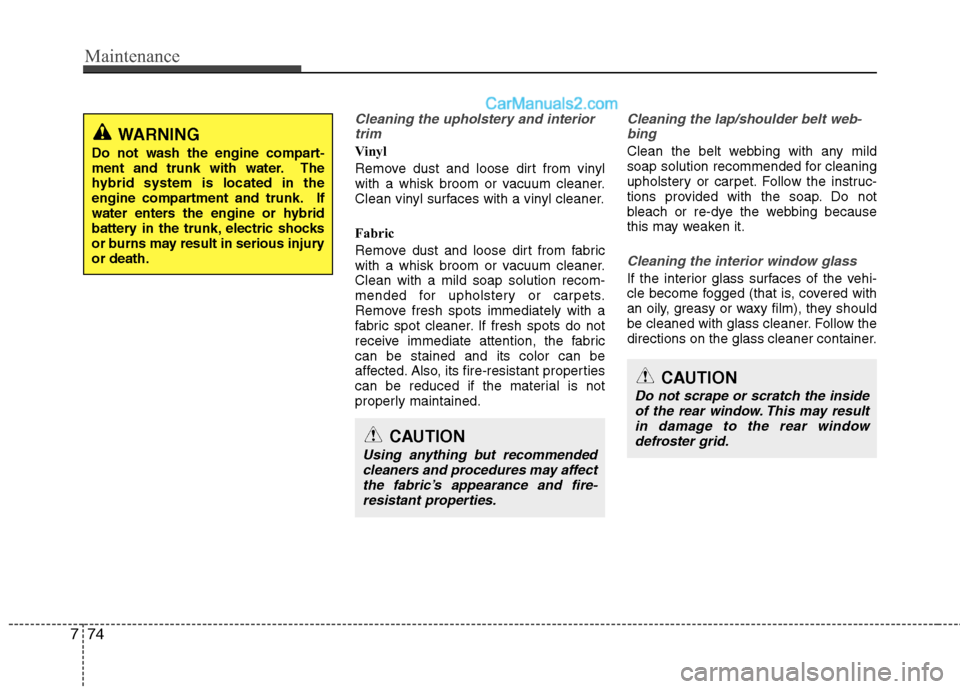
Maintenance
74 7
Cleaning the upholstery and interior
trim
Vinyl
Remove dust and loose dirt from vinyl
with a whisk broom or vacuum cleaner.
Clean vinyl surfaces with a vinyl cleaner.
Fabric
Remove dust and loose dirt from fabric
with a whisk broom or vacuum cleaner.
Clean with a mild soap solution recom-
mended for upholstery or carpets.
Remove fresh spots immediately with a
fabric spot cleaner. If fresh spots do not
receive immediate attention, the fabric
can be stained and its color can be
affected. Also, its fire-resistant properties
can be reduced if the material is not
properly maintained.
Cleaning the lap/shoulder belt web-
bing
Clean the belt webbing with any mild
soap solution recommended for cleaning
upholstery or carpet. Follow the instruc-
tions provided with the soap. Do not
bleach or re-dye the webbing because
this may weaken it.
Cleaning the interior window glass
If the interior glass surfaces of the vehi-
cle become fogged (that is, covered with
an oily, greasy or waxy film), they should
be cleaned with glass cleaner. Follow the
directions on the glass cleaner container.
CAUTION
Using anything but recommended
cleaners and procedures may affect
the fabric’s appearance and fire-
resistant properties.
CAUTION
Do not scrape or scratch the inside
of the rear window. This may result
in damage to the rear window
defroster grid.
WARNING
Do not wash the engine compart-
ment and trunk with water. The
hybrid system is located in the
engine compartment and trunk. If
water enters the engine or hybrid
battery in the trunk, electric shocks
or burns may result in serious injury
or death.
Page 408 of 425
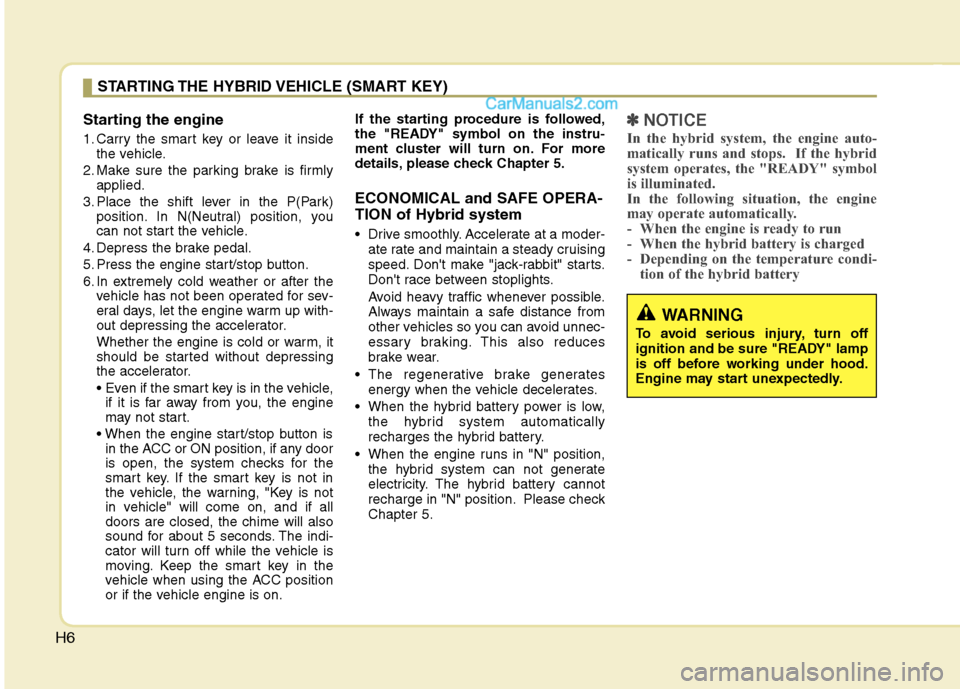
H6
Starting the engine
1. Carry the smart key or leave it inside
the vehicle.
2. Make sure the parking brake is firmly
applied.
3. Place the shift lever in the P(Park)
position. In N(Neutral) position, you
can not start the vehicle.
4. Depress the brake pedal.
5. Press the engine start/stop button.
6. In extremely cold weather or after the
vehicle has not been operated for sev-
eral days, let the engine warm up with-
out depressing the accelerator.
Whether the engine is cold or warm, it
should be started without depressing
the accelerator.
if it is far away from you, the engine
may not start.
in the ACC or ON position, if any door
is open, the system checks for the
smart key. If the smart key is not in
the vehicle, the warning, "Key is not
in vehicle" will come on, and if all
doors are closed, the chime will also
sound for about 5 seconds. The indi-
cator will turn off while the vehicle is
moving. Keep the smart key in the
vehicle when using the ACC position
or if the vehicle engine is on.If the starting procedure is followed,
the "READY" symbol on the instru-
ment cluster will turn on. For more
details, please check Chapter 5.
ECONOMICAL and SAFE OPERA-
TION of Hybrid system
Drive smoothly. Accelerate at a moder-
ate rate and maintain a steady cruising
speed. Don't make "jack-rabbit" starts.
Don't race between stoplights.
Avoid heavy traffic whenever possible.
Always maintain a safe distance from
other vehicles so you can avoid unnec-
essary braking. This also reduces
brake wear.
The regenerative brake generates
energy when the vehicle decelerates.
When the hybrid battery power is low,
the hybrid system automatically
recharges the hybrid battery.
When the engine runs in "N" position,
the hybrid system can not generate
electricity. The hybrid battery cannot
recharge in "N" position. Please check
Chapter 5.
✽ ✽
NOTICE
In the hybrid system, the engine auto-
matically runs and stops. If the hybrid
system operates, the "READY" symbol
is illuminated.
In the following situation, the engine
may operate automatically.
- When the engine is ready to run
- When the hybrid battery is charged
- Depending on the temperature condi-
tion of the hybrid battery
STARTING THE HYBRID VEHICLE (SMART KEY)
WARNING
To avoid serious injury, turn off
ignition and be sure "READY" lamp
is off before working under hood.
Engine may start unexpectedly.
Page 410 of 425
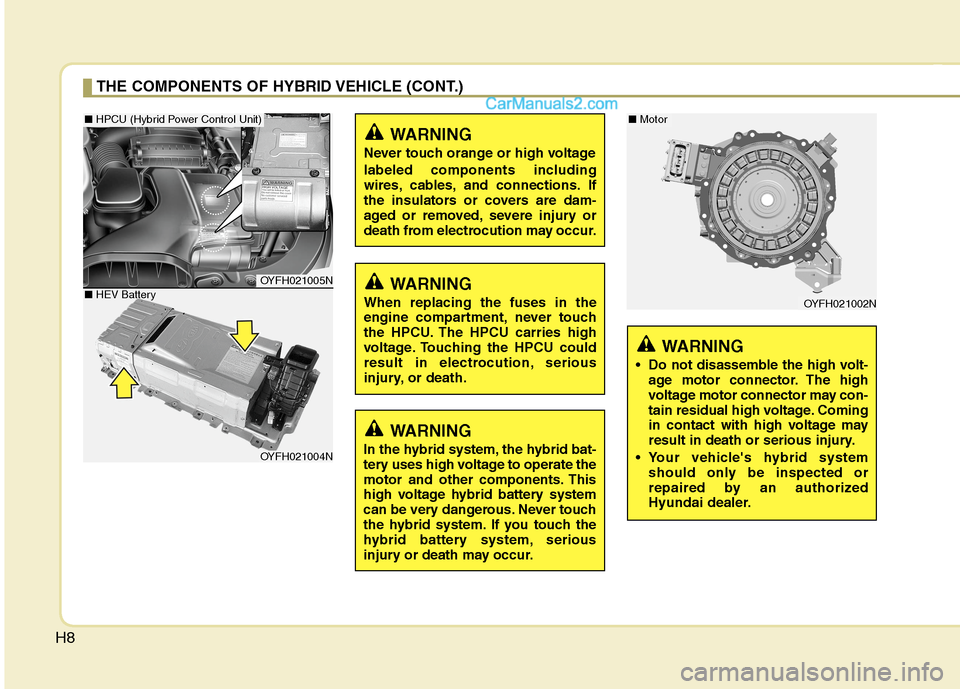
H8
THE COMPONENTS OF HYBRID VEHICLE (CONT.)
WARNING
In the hybrid system, the hybrid bat-
tery uses high voltage to operate the
motor and other components. This
high voltage hybrid battery system
can be very dangerous. Never touch
the hybrid system. If you touch the
hybrid battery system, serious
injury or death may occur.
WARNING
Never touch orange or high voltage
labeled components including
wires, cables, and connections. If
the insulators or covers are dam-
aged or removed, severe injury or
death from electrocution may occur.
WARNING
When replacing the fuses in the
engine compartment, never touch
the HPCU. The HPCU carries high
voltage. Touching the HPCU could
result in electrocution, serious
injury, or death.
OYFH021005N
OYFH021004N
OYFH021002N
WARNING
• Do not disassemble the high volt-
age motor connector. The high
voltage motor connector may con-
tain residual high voltage. Coming
in contact with high voltage may
result in death or serious injury.
Your vehicle's hybrid system
should only be inspected or
repaired by an authorized
Hyundai dealer.
■ HPCU (Hybrid Power Control Unit)■ Motor
■ HEV Battery
Page 411 of 425
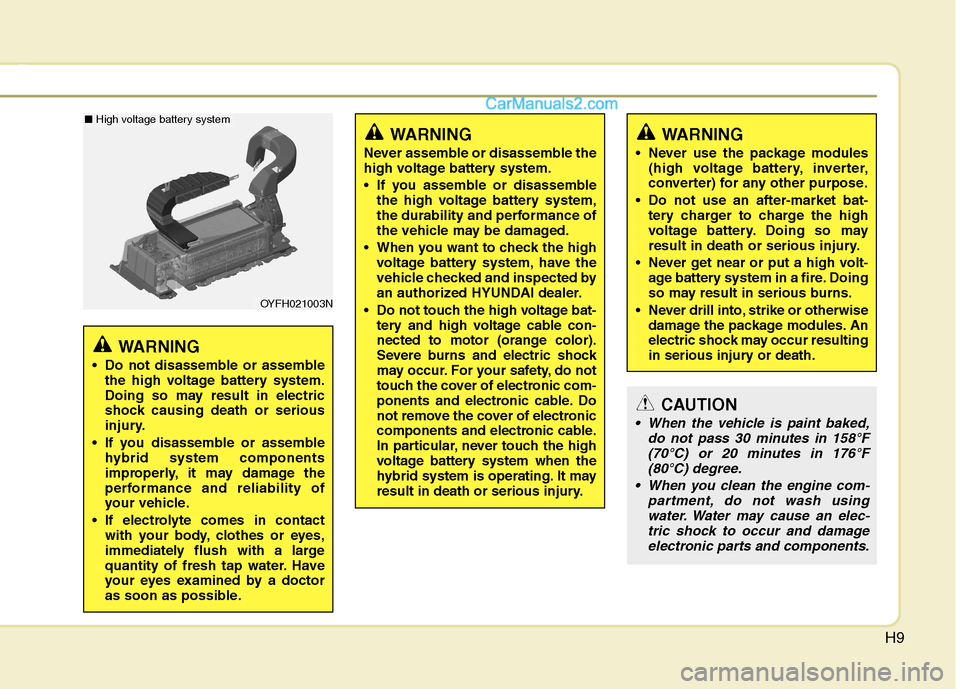
H9
WARNING
Do not disassemble or assemble
the high voltage battery system.
Doing so may result in electric
shock causing death or serious
injury.
If you disassemble or assemble
hybrid system components
improperly, it may damage the
performance and reliability of
your vehicle.
If electrolyte comes in contact
with your body, clothes or eyes,
immediately flush with a large
quantity of fresh tap water. Have
your eyes examined by a doctor
as soon as possible.
WARNING
Never assemble or disassemble the
high voltage battery system.
If you assemble or disassemble
the high voltage battery system,
the durability and performance of
the vehicle may be damaged.
When you want to check the high
voltage battery system, have the
vehicle checked and inspected by
an authorized HYUNDAI dealer.
Do not touch the high voltage bat-
tery and high voltage cable con-
nected to motor (orange color).
Severe burns and electric shock
may occur. For your safety, do not
touch the cover of electronic com-
ponents and electronic cable. Do
not remove the cover of electronic
components and electronic cable.
In particular, never touch the high
voltage battery system when the
hybrid system is operating. It may
result in death or serious injury.
OYFH021003N
WARNING
Never use the package modules
(high voltage battery, inverter,
converter) for any other purpose.
Do not use an after-market bat-
tery charger to charge the high
voltage battery. Doing so may
result in death or serious injury.
Never get near or put a high volt-
age battery system in a fire. Doing
so may result in serious burns.
Never drill into, strike or otherwise
damage the package modules. An
electric shock may occur resulting
in serious injury or death.
CAUTION
When the vehicle is paint baked,
do not pass 30 minutes in 158°F
(70°C) or 20 minutes in 176°F
(80°C) degree.
When you clean the engine com-
partment, do not wash using
water. Water may cause an elec-
tric shock to occur and damage
electronic parts and components.
■ High voltage battery system
Page 412 of 425

H10
Safety plug
This safety plug (1) located in the rear
trunk as shown should always be pulled
out to disconnect and turn off the hybrid
system.
IMPORTANT: Wait 5 minutes after this
lever is disconnected to work on the
car to assure all remaining charge in
the system has dissipated.
The special features of hybrid
vehicle.
Hybrid vehicles sound different than
gasoline engine vehicles. When the
hybrid system operates, you may hear a
sound from the hybrid battery system
behind the rear seat. If you apply the
accelerator pedal rapidly, you may hear
an unconventional sound. When you
apply the brake pedal, you may hear a
sound from the regenerative brake sys-
tem. When the hybrid system is turned
off or on, you may hear a sound in the
engine compartment. If you depress the
brake pedal repeatedly when the hybrid
system is turned on, you may hear a
sound in the engine compartment. None
of these sounds indicate a problem.
These are normal characteristics of
hybrid vehicles.
If any of following occur, it's a normal
condition if you hear a motor sound in the
engine compartment:
- After turning off the hybrid system, the
brake pedal is released.
- When the hybrid system is turned off,
the brake pedal is applied.
- When the driver door is opened.
THE COMPONENTS OF HYBRID VEHICLE (CONT.)
WARNING
This hybrid vehicle uses the hybrid
battery system inverter and con-
verter to generate high voltage.
High voltage in the hybrid battery
system is very dangerous and can
cause severe burns and electric
shock. This may result in serious
injury or death.
For your safety, never touch,
replace, dismantle or remove the
hybrid battery system including
components, cables and connec-
tors. Severe burns or electric
shock may result in serious
injury or death if you do not fol-
low this warning.
When the hybrid battery system
operates, the hybrid battery sys-
tem can be hot. Always be careful
because burns or electric shock
may be caused by high voltage.
Do not drop water or liquid on to
HPCU, HSG, Motor and fuses. The
hybrid system components are
covered. If you drop water or liq-
uid on to hybrid system compo-
nents, it may result in electric
shock.
DANGER
Never touch the safety plug. Safety
plug is attached to high voltage
hybrid battery system. Touching
safety plug will result in death or seri-
ous injury. Service personnel should
follow procedure in service manual.
OYFH061020N